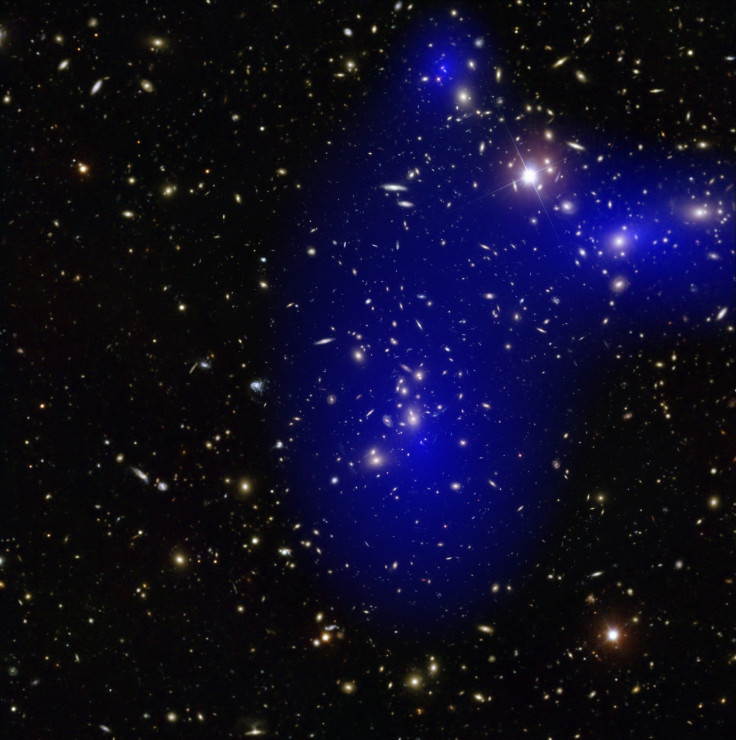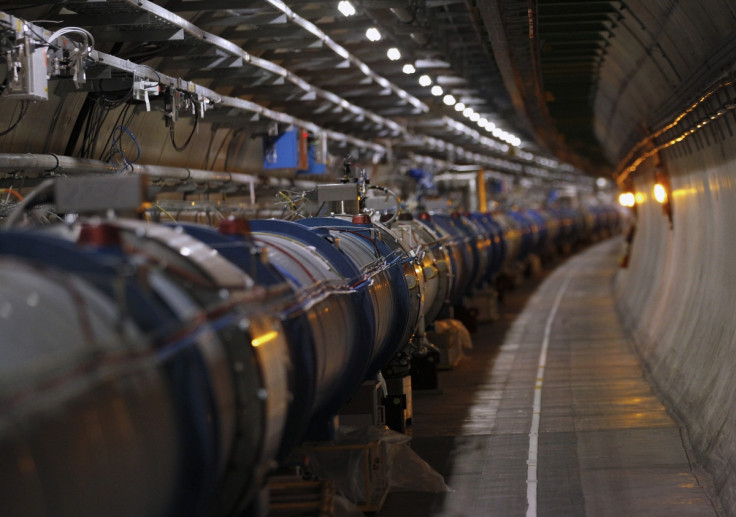Colliding galaxy clusters suggest there is no dark matter mirror universe

A mirror universe of dark matter particles is unlikely to exist, a study of colliding galaxy clusters has suggested.
Dark matter is the biggest mystery in the universe. It accounts for 90% of all matter in the universe and a quarter of its energy – yet we know very little about it. It is invisible and does not correspond to anything within the realms of our experience.
However, we know it is there and that it interacts with cosmic structures through gravity. It bends light that passes through it and speeds up the motion of galaxies inside galaxy clusters – collections of hundreds of galaxies and made up of about 90% dark matter.
Published in the journal Science, researchers have now found that dark matter does not interact with itself, placing constraints on a number of theories about its nature.
The Bullet Cluster
The best evidence scientists currently have of the existence of dark matter is the famous Bullet Cluster collision.
David Harvey, from École Polytechnique Fédérale de Lausanne (EPFL), was lead author on the latest study of colliding galaxy clusters: "The Bullet Cluster was the first true evidence we had for dark matter," he told IBTimes UK. "Everything before that, we had all this evidence but it could be explained if we modified the laws of gravity. The Bullet Cluster was the first real evidence we had that couldn't be explained by changing the laws of gravity.
"What happens is you have these galaxy clusters – these huge structures in the universe that consist of thousands of galaxies all orbiting around normally one very large galaxy like electrons orbit in a nucleus, then they have an orbit inside this big sea of hot ionised gas, which is giving off x-rays.
"The galaxies are inside a bigger ball of dark matter and what happens is these huge structures can be drawn by gravity towards other galaxy clusters of similar size. When these things happen, they crash together and the galaxy's gas and dark matter behaves differently."
Harvey said that in the Bullet Cluster collision, the galaxy clusters go through each other. The galaxies themselves go through unimpeded, but the gas interacts and drags, causing it to slowdown – it separates away from the galaxy.
Dark matter, they found, passed through with the galaxy, so scientists inferred that it did not interact with the gas or the oncoming dark matter: "When we looked at the total mass we saw that [the dark matter] was all around the galaxies, so we can see that it has become separated from the gas in the collision – that's why it was the first proof that dark matter existed."
More evidence supporting the Bullet Cluster

The Bullet Cluster was just one example, however. So Harvey and his team studied data from 72 galaxy cluster collisions over the course of billions of years. The data, from the Chandra X-ray Space Observatory and the Hubble telescope, included collisions of two, three and four merging clusters.
"The Bullet cluster was a very special case – it seemed to be head on and very lucky – a lot of them are very messy. What we did was build up a statistical sample by pulling out each merging galaxy cluster – for example in the Bullet Cluster there were two galaxies merging, two data points if you like," he said.
"In some of the galaxy clusters there were three merging, in some there were four. In total we pulled out 72 of these sets of dark matter, gas and galaxies."
Scientists wanted to see if the dark matter would stick with the galaxy cluster in other collisions, or if the Bullet Cluster was just an anomaly. In experiments in the Large Hadron Collider, it appears that when subatomic particles interact, they exchange momentum – by looking at what happens to dark matter after collisions, they could find out more about its nature.
Two scenarios were considered. Dark matter particles would either interact frequently but exchange little momentum, or they would interact rarely but exchange a lot of momentum. If the first scenario was true, the dark matter would slow down after collision, because the interaction would cause an additional drag. In the second scenario, it would scatter into space.
However, findings showed the dark matter particles simply passed through each other.
"We took this sample and measured where the dark matter was relative to the galaxies and gas. We found the dark matter stayed even closer to the galaxies than we'd previously seen. We can say the dark matter was acting very similar to the galaxies during these cluster crashes in the sense that the dark matter was not even recognising that any of the other dark matter was there."
What does it mean?

The findings suggest that dark matter particles do not interact with each other, challenging a number of theories about what it is. Some theories say it could be a quantum defect from the beginning of the universe, a modified form of gravity or an extra-dimensional mass.
However, it mainly contests the idea that it consists of a subatomic particle we have not discovered yet. Scientists have suggested dark matter has proton-like particles.
The authors were looking to see if when dark matter particles collide, if they had interactions similar to two protons: "When two protons interact they'll exchange protons and they'll scatter because they're both positively charged - like two magnets interact when they push away from one another. When protons interact they scatter," Harvey said.
"We were looking to see if a similar thing happens with dark matter – does dark matter scatter similarly to electrode static forces, magnets, because that would result in a drag.
"What this is telling us about the nature of dark matter is the chances are it's very unlikely dark matter will have this family of dark photons. There's a good chance that dark matter won't have this dark photon and dark proton world, where dark particles go around and scatter in their own electrostatic way but in the dark setting.
"There's a smaller chance now that there's this mirror universe of dark particles that have a similar thing to what we see, but on the dark side. It sounds very Star Wars."
What next?
What the study does is place constraints on theories about dark matter – but models can always be changed and adapted: "Theories of dark matter mostly favour this one particular particle that we haven't found yet, but you can always change models. We're ruling out a large parameter space, but that's not to say that we can't have this weird universe where dark matter still is this interacting thing."
© Copyright IBTimes 2024. All rights reserved.






